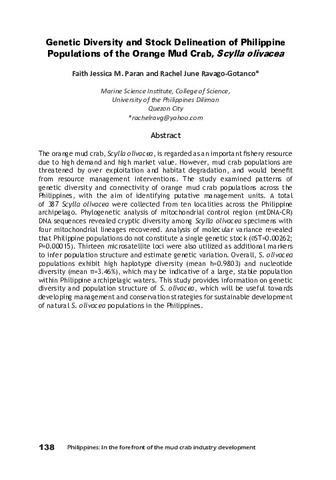A statistical procedure for using "reference fish" to compare the growth of genetic strains in aquaculture
- Global styles
- MLA
- Vancouver
- Elsevier - Harvard
- APA
- Help
Share
Abstract
No simple, well-accepted procedures exist for comparing the relative performance of genetic strains of fish in aquaculture environments. The major technical problem is providing adequate statistical replication of ponds or cages. Inclusion of an "internal reference" population of standard fish in each pond can reduce replicate error caused by variation in the physical environment, food supply and population density. This statistical procedure is feasible only if there is no biological interaction (interference competition) between the strain and the reference fish. An experimental design is described in which the replicates contain different proportions of reference fish relative to the test strains. This permits the effects of interstrain interference to be estimated. Data from growth of tilapia Oreochromis mossambicus in crowded aquaria are used to illustrate the effect of interference and other nonlinearities in the experimental design.
Type
Conference paperKoleksi
- Conference Proceedings [298]
Related items
Showing items related by title, author, creator and subject.
-
Genetic diversity and stock delineation of Philippine populations of the orange mud crab, Scylla olivacea
Paran, Faith Jessica M.; Ravago-Gotanco, Rachel June (Aquaculture Department, Southeast Asian Fisheries Development Center, 2017)The orange mud crab, Scylla olivacea, is regarded as an important fishery resource due to high demand and high market value. However, mud crab populations are threatened by over exploitation and habitat degradation, and ... -
Population genetic variation and genetic structure of widely distributed Japanese endemic freshwater crustaceans: Geothelphusa dehaani and Gammarus nipponensis
Freshwater crustaceans, Geothelphusa dehaani (White 1847) and Gammarus nipponensis (Ueno 1940), are commonly found in rivers, streams and lakes in Japan. The distribution range of G. nipponensis is concentrated in the ... -
Genetic assessment of philippine milkfish (Chanos chanos) stocks based on novel microsatellites for markeraided broodstock management
Romana-Eguia, Maria Rowena R. ; Santos, Brian S.; Ikeda, Minoru; Basiao, Zubaida U.; de Jesus-Ayson, Evelyn Grace T.; Kijima, Akihiro (Elsevier, 2017)
Reports on genetic diversity within/among milkfish populations using DNA markers are sparse. Earlier work dealt with evolutionary relationships among wild populations to define management units in the Indo-Pacific region ...33 Total citations0 Recent citations0.57 Field Citation Ration/a Relative Citation Ratio
; Santos, Brian S.; Ikeda, Minoru; Basiao, Zubaida U.; de Jesus-Ayson, Evelyn Grace T.; Kijima, Akihiro (Elsevier, 2017)
Reports on genetic diversity within/among milkfish populations using DNA markers are sparse. Earlier work dealt with evolutionary relationships among wild populations to define management units in the Indo-Pacific region ...33 Total citations0 Recent citations0.57 Field Citation Ration/a Relative Citation Ratio



